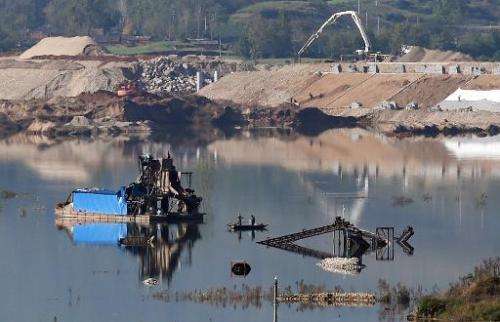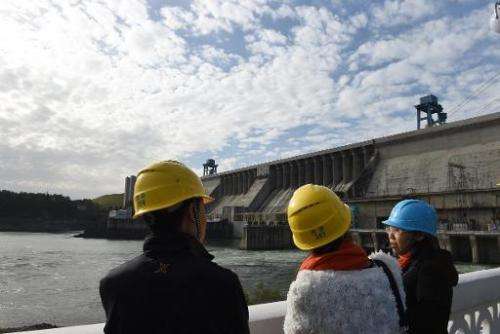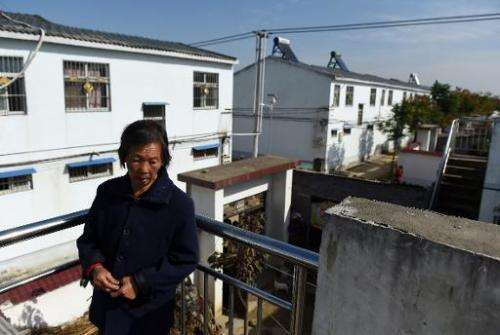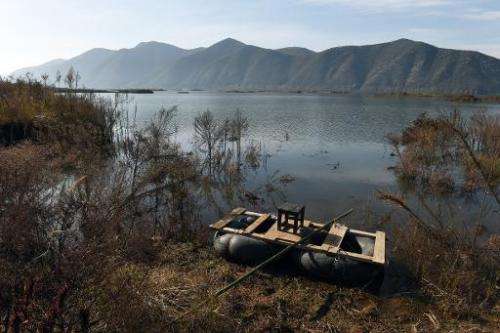A partially-submerged factory is pictured near Jianying village in China's central Henan province on November 3, 2014
Before their villages were submerged beneath a gargantuan scheme to move water hundreds of kilometres to China's arid north, government officials promised farmers better lives far from their ancestral homes.
Water is due to start flowing this month along the central route of the South-North Water Diversion project, a monumental $81 billion design to salve the thirst of Beijing and surrounding regions.
But many of the more than 300,000 people who made way for it have been left unemployed in leaking, shoddy houses, while few say they have been given the compensation they were pledged.
The grand scheme was suggested by Communist China's founding father Mao Zedong more than 60 years ago, and analysts say the migrants' plight shows how little megaproject management has changed since his era.
Jia Xinlong remembers pounding rain soaking the ground as an entire village loaded their possessions—generations' worth of furniture and agricultural tools—onto lorries which would take them more than 300 kilometres away.
When they arrived three years ago at their new home—a clump of dozens of identical white houses rising out of surrounding fields called Yaojia New Migrant Village—some burst into tears.
"We felt uneasy. The houses were badly built, the ceilings were already cracking," Jia said, pointing out gaps in the plastered roofing of a shop.
"We made a sacrifice for the country," said his friend Jia Zhangjun, "and we lost out."
'The country asked us'
The Chinese government says the project will solve a chronic shortage in the cities of the country's north, supplying Beijing with a billion cubic metres of water every year.
Northern China supports nearly half the country's population and economy but has just a fifth of the national water supply, according to the World Bank.
Recent statistics show that Beijing's water levels have fallen to just 120 cubic metres per person—less than Algeria and roughly on par with Yemen and Israel, all three of them largely desert.
People visit the Danjiangkou dam in Danjiankou, China's central Hubei province, on November 2, 2014
The South-North Water Diversion project is an attempt to address the shortfall by reshaping the very geography of China, and according to state media its middle route has required at least 330,000 people in the central provinces of Henan and Hubei to move.
Migrants in four villages visited by AFP had their homes submerged under the newly expanded Danjiangkou reservoir, from where water flows to the capital through 1,264 kilometres of pipes.
"The country asked us to move. So we had no choice," said Xu Zhenyan, an elderly man who was transplanted 150 kilometres to Liangzhuangdong New Village.
Huang Jianchao, 50, said that transport was better in their new home, "but there's no work to do, and we have less land than before"—a regularly echoed complaint. "My income was higher before we moved".
The relocation office of Nanyang city, where the four villages are located, told AFP that all migrants received at least 700 square metres of "productive" land, and a 600 yuan annual payment for 20 years.
It admitted that "embezzlement" of relocation funds was a problem but said the number of cases "was not too many to be checked".
Nonetheless more than a dozen migrants interviewed by AFP said that they had not received their payments, blaming corruption.
"We haven't received anything," said Liang Qingfeng, 40, in Liangzhuangdong. "The central policies are good, but they aren't enforced."
'Satisfaction doesn't matter'
The displaced are among millions of Chinese relocated in recent decades by vast engineering experiments that have fuelled the country's economic boom.
A woman stands among apartments built for villagers relocated to make way for the expansion of the Danjiangkou reservoir, at Liangzhuang East village in China's central Henan province on November 3, 2014
More than a million people were moved to make way for the massive Three Gorges dam—the world's largest by generating capacity—before it opened around a decade ago.
Thousands remain in poverty, and China's government in 2012 made a rare admission that the treatment of migrants relocated for the dam was still an "urgent problem".
In the 1950s, more 400,000 people were forced to relocate to make way for the Sanmenxia dam in northern China. A senior official later described the dam as "a stupid mistake" after it clogged with silt.
Those forced to move for the latest megaproject are victims of China's centralised politics, said academics who have studied it.
"The cities and communities around the Danjiangkou reservoir are politically and economically less important than China's capital region," said Britt-Crow Miller, assistant professor of geography at the University of California, adding the migrants were left "without choice in the matter".
A home-made raft is seen beside an expanded section of the Danjiangkou reservoir near Jianying village in China's central Henan province on November 3, 2014
Scott Moore at Harvard University's Kennedy School of Government said the project planning showed that "not much has changed since Mao in terms of public consultation".
But despite their disappointments, some migrants spoke with pride of "making a contribution" to China's development.
In a rare migrant village constructed within sight of its original location, a 71-year-old woman surnamed Liu pointed towards her house, now submerged under an enormous blue reservoir.
"We all miss home because our ancestors are buried there. On important festivals we need to return there to burn offerings," she said.
"Whether we are satisfied doesn't matter. It's a national policy. When we are called, satisfaction doesn't come into it."
© 2014 AFP

























